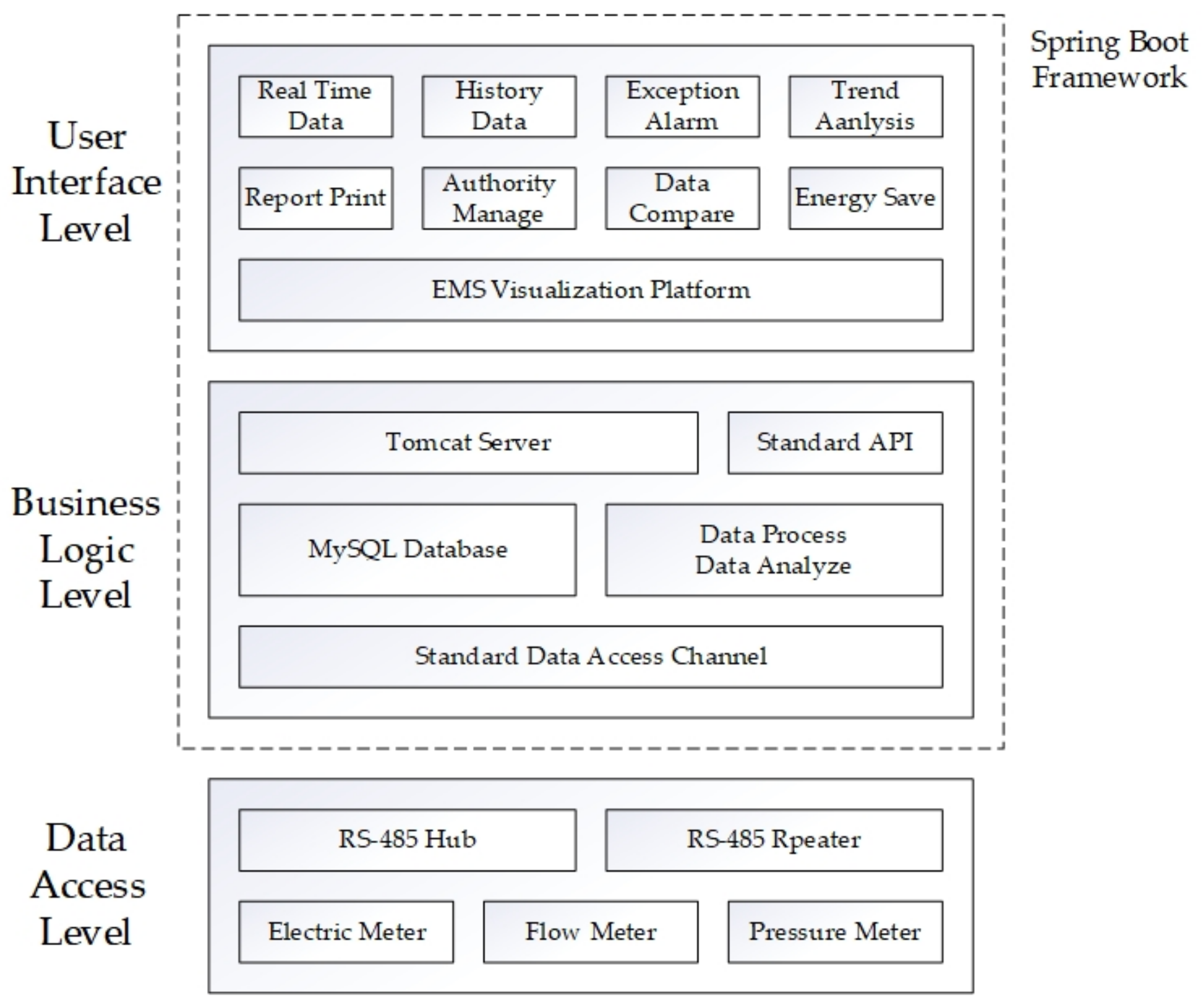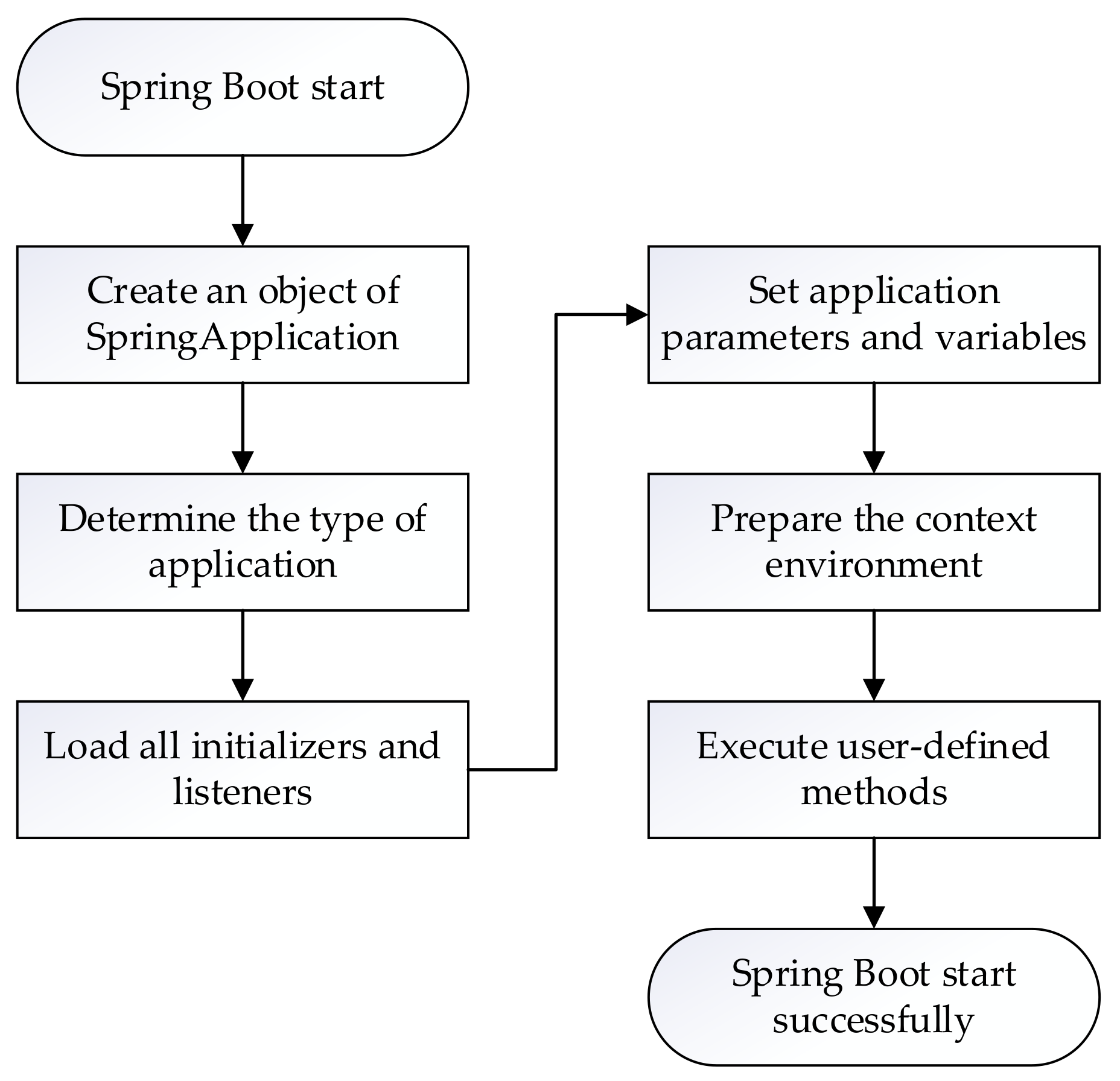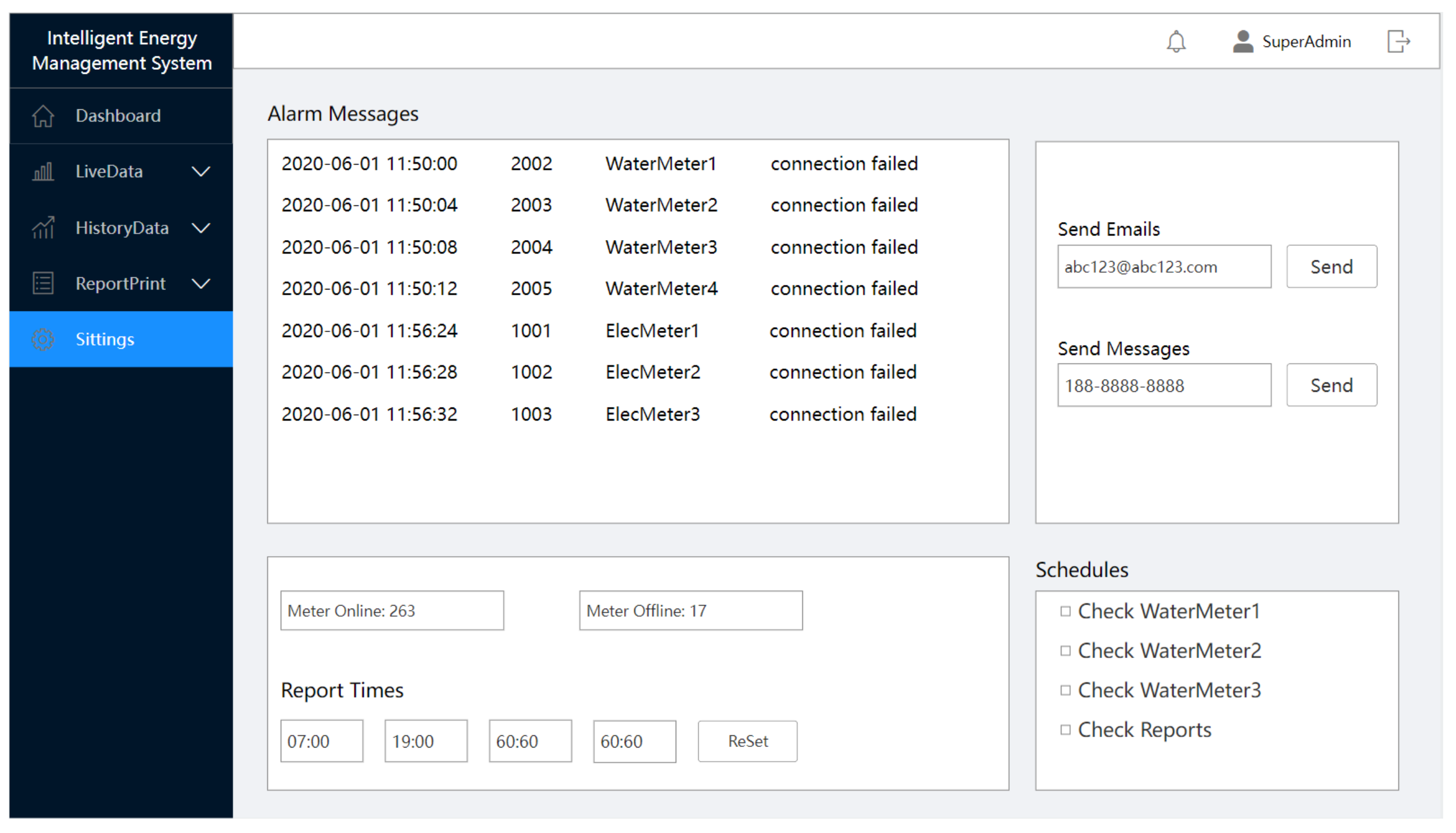Design and Implementation of Energy Management System Based on Spring Boot Framework
Abstract
:1. Introduction
2. Design of System Architecture
2.1. Data Collection Layer
2.2. Business Logic Layer
2.2.1. Design of the Database
2.2.2. Application of Spring Boot Framework
- The system looks for the annotation named @SpringBootApplication and creates an in-stance object of SpringApplication as the main entrance of the program;
- The type of application is determined (a web application in this case);
- All initializers and all listeners are loaded;
- Application parameters and environment variables are set;
- The context environment is prepared. This is the core step of the Spring Boot framework startup. The dependencies of third-party libraries, automatic configuration, and the startup of the built-in server Tomcat are established in this step;
- User-defined methods are executed. This marks the completion of the Spring Boot application before normal work can begin.
2.3. Display Interface Layer
2.4. Development Cost Calculation
3. System Operation and Analysis
4. Conclusions
Author Contributions
Funding
Institutional Review Board Statement
Informed Consent Statement
Data Availability Statement
Conflicts of Interest
References
- Wei, J.Y.; Zhao, X.Y.; Sun, X.S. The evaluation model of the enterprise energy efficiency based on DPSR. Environ. Sci. Pollut. Res. 2019, 26, 16835–16846. [Google Scholar] [CrossRef] [PubMed]
- Goncalves, V.S.; Jose, M. Energy management system iso 50001:2011 and energy management for sustainable development. Energy Policy 2019, 133, 110868. [Google Scholar]
- Irtija, N.; Sangoleye, F.; Tsiropoulou, E.E. Contract-Theoretic Demand Response Management in Smart Grid Systems. IEEE Access 2020, 8, 184976–184987. [Google Scholar] [CrossRef]
- Yu, M.; Yue, G.; Song, J.; Pang, X. Research on intelligent city energy management based on internet of things. Clust. Comput. 2019, 22, S8291–S8300. [Google Scholar] [CrossRef]
- Raji, M.N.; Maksimovi, R.M.; Milosavljevi, P.; Pavlovi, D. Energy Management System Application for Sustainable Development in Wood Industry Enterprises. Sustainability 2019, 12, 76. [Google Scholar] [CrossRef] [Green Version]
- Jia, B. Research and Application of Small Area Energy Management System. Master′s Thesis, Shandong University, Jinan, China, 8 June 2020. [Google Scholar]
- Sa, A.; Thollander, P.; Rafiee, M. Industrial Energy Management Systems and Energy-Related Decision-Making. Energies 2018, 11, 2784. [Google Scholar] [CrossRef] [Green Version]
- Choi, J.S. Energy Management Agent Frameworks: Scalable, Flexible, and Efficient Architectures for 5G Vertical Industries. IEEE Ind. Electron. Mag. 2021, 15, 62–73. [Google Scholar] [CrossRef]
- Barabanova, I.A.; Kravets, O.J.; Tkalich, S.A.; Muting, D.I. Analysis of the intermediate layer work in the three-tier architecture “client-server” of automation engineering problems. IOP Conf. Ser. Mater. Sci. Eng. 2019, 537, 032011. [Google Scholar]
- Zhao, Y.J.; Ma, J.N.; Li, S.J.; Li, J. Design of Modbus Wireless Communication System Based on Remote Data Transmission. In Proceedings of the 2016 International Forum on Mechanical, Control and Automation, Shenzhen, China, 30–31 December 2016. [Google Scholar]
- Yue, G. Design of Intelligent Monitoring and Control System Based on Modbus. In Proceedings of the 5th International Conference on Communication, Image and Signal Processing, Chengdu, China, 13–15 November 2020. [Google Scholar]
- Wang, S.; You, H.; Yue, Y.; Cao, L. A novel topology optimization of coverage-oriented strategy for wireless sensor networks. Int. J. Distrib. Sens. Netw. 2021, 17. Available online: https://journals.sagepub.com/doi/full/10.1177/1550147721992298 (accessed on 2 November 2021). [CrossRef]
- Yang, Y.; Mei, Z.; Zheng, B.; Qiu, S. Design of Enterprise Management System Based on Edge Computing Architecture. Mob. Inf. Syst. 2021, 2021, 5512958. [Google Scholar]
- Eyada, M.; Saber, W.; Genidy, M.; Amer, F. Performance Evaluation of IoT Data Management Using MongoDB Versus MySQL Databases in Different Cloud Environments. IEEE Access 2020, 8, 110656–110668. [Google Scholar] [CrossRef]
- Ordonez, C.; Al-Amin, S.T.; Bellatreche, L. An ER-Flow Diagram for Big Data. In Proceedings of the 2020 IEEE International Conference on Big Data (Big Data), Atlanta, GA, USA, 10–13 December 2020; Available online: https://www.webofscience.com/wos/alldb/full-record/WOS:000662554705140 (accessed on 2 November 2021).
- Liu, T.Y. Design and Implementation of Distributed Mall Based on SSM. Master′s Thesis, China University of Geosciences, Beijing, China, May 2020. [Google Scholar]
- Miao, K.H.; Li, J.; Hong, W.X.; Chen, M.T. A Microservice-Based Big Data Analysis Platform for Online Educational Applications. Sci. Program. 2020, 2020, 6929750. Available online: https://www.hindawi.com/journals/sp/2020/6929750/ (accessed on 2 November 2021). [CrossRef]
- Li, M.H.; Hu, J.H.; Lin, X.W. The Development of Web Application Front-End of Intelligent Clinic Based on Vue.js. In Proceedings of the 2019 Chinese Intelligent Automation Conference, Nanjing, China, 20–22 September 2019; Lecture Notes in Electrical Engineering. Available online: https://link.springer.com/chapter/10.1007/978-981-32-9050-1_77 (accessed on 2 November 2021).
- Ban, X.J.; Wang, B.; Cheng, C.X.; Taghzouit, S. Iron and Steel Enterprises Big Data Visualization Analysis Based on Spark. In Proceedings of the 15th International Conference on Cooperative Design, Visualization and Engineering, Hangzhou, China, 21–24 October 2018; Lecture Notes in Computer Science. Available online: https://link.springer.com/chapter/10.1007%2F978-3-030-00560-3_39 (accessed on 2 November 2021).










| Fields | Type | Remarks |
|---|---|---|
| id | int (4) | Unique number |
| name | varchar (50) | Name of meter |
| address | int (4) | Modbus address |
| type | int (4) | Type of meter |
| time | datetime (0) | Data collection time |
| rate | decimal (18.2) | Instantaneous flow |
| total | decimal (18.2) | Cumulative flow |
| temperature | decimal (18.2) | Temperature |
| pressure | decimal (18.2) | Pressure |
| Data Tables | Data Volume | Error Rate |
|---|---|---|
| data_202001 | 1,293,399 | 0.20% |
| data_202002 | 1,293,852 | 0.17% |
| data_202003 | 1,292,964 | 0.23% |
| data_202004 | 1,294,002 | 0.15% |
| data_202005 | 1,289,634 | 0.49% |
| data_202006 | 1,293,600 | 0.19% |
| data_202007 | 1,292,646 | 0.26% |
| data_202008 | 1,294,892 | 0.09% |
| data_202009 | 1,293,996 | 0.15% |
| data_202010 | 1,294,268 | 0.13% |
| data_202011 | 1,293,983 | 0.16% |
| data_202012 | 1,294,103 | 0.15% |
Publisher’s Note: MDPI stays neutral with regard to jurisdictional claims in published maps and institutional affiliations. |
© 2021 by the authors. Licensee MDPI, Basel, Switzerland. This article is an open access article distributed under the terms and conditions of the Creative Commons Attribution (CC BY) license (https://creativecommons.org/licenses/by/4.0/).
Share and Cite
Zhang, F.; Sun, G.; Zheng, B.; Dong, L. Design and Implementation of Energy Management System Based on Spring Boot Framework. Information 2021, 12, 457. https://doi.org/10.3390/info12110457
Zhang F, Sun G, Zheng B, Dong L. Design and Implementation of Energy Management System Based on Spring Boot Framework. Information. 2021; 12(11):457. https://doi.org/10.3390/info12110457
Chicago/Turabian StyleZhang, Fang, Guiling Sun, Bowen Zheng, and Liang Dong. 2021. "Design and Implementation of Energy Management System Based on Spring Boot Framework" Information 12, no. 11: 457. https://doi.org/10.3390/info12110457
APA StyleZhang, F., Sun, G., Zheng, B., & Dong, L. (2021). Design and Implementation of Energy Management System Based on Spring Boot Framework. Information, 12(11), 457. https://doi.org/10.3390/info12110457






